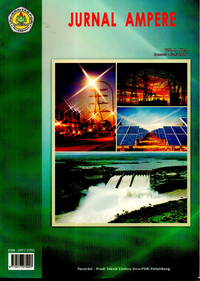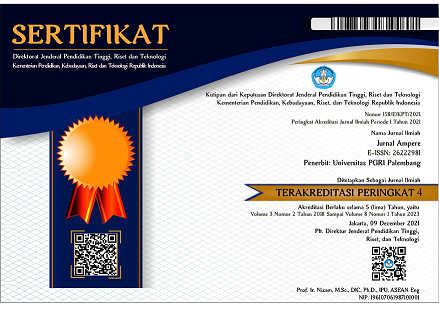PREDIKSI KEBUTUHAN LISTRIK JANGKA PENDEK MENGGUNAKAN MOVING AVERAGE
DOI:
https://doi.org/10.31851/ampere.v1i2.899Abstract
ABSTRAK
Prediksi kebutuhan energi listrik jangka pendek mempunyai peran penting dalam perencanaan sistem tenaga listrik yaitu untuk penjadwalan dan pengaturan pembangkit cadangan. Hal ini nantinya akan berdampak pada kemampuan perusahaan penyedia tenaga listrik dalam menyediakan energi listrik yang handal kepada konsumen, namun tetap ekonomis. Salah satu metode yang dapat digunakan dalam prediksi tersebut adalah Moving Average yang merupakan salah satu metode penyelesaian untuk time series analysis (analisa runtun waktu)  Pada penelitian ini dilakukan prediksi beban listrik jangka pendek di wilayah Sumbagsel menggunakan metode Moving Average berbasiskan software SPSS 16. Hasil prediksi yang diperoleh, akan dibandingkan dengan hasil aktual. Dari hasil perhitungan, dapat disimpulkan bahwa rata-rata MAPE hasil prediksi selama satu minggu, menggunakan Moving Average sebesar 4,7817% masih berada dalam batas toleransi deviasi peramalan beban yang ditentukan oleh PLN yaitu sebesar ± 5%.
Â
Kata kunci : prediksi kebutuhan listrik, Sumbagsel, Moving Average, SPSS, MAPE
Downloads
Published
How to Cite
Issue
Section
License

Jurnal Ampere is licensed under a Creative Commons Attribution-ShareAlike 4.0 International License.
Authors who publish with this journal agree to the following terms:
- Authors retain copyright and grant the journal right of first publication with the work simultaneously licensed under a Creative Commons Attribution License that allows others to share the work with an acknowledgement of the work's authorship and initial publication in this journal.
- Authors are able to enter into separate, additional contractual arrangements for the non-exclusive distribution of the journal's published version of the work (e.g., post it to an institutional repository or publish it in a book), with an acknowledgement of its initial publication in this journal.
- Authors are permitted and encouraged to post their work online (e.g., in institutional repositories or on their website) prior to and during the submission process, as it can lead to productive exchanges, as well as earlier and greater citation of published work.






